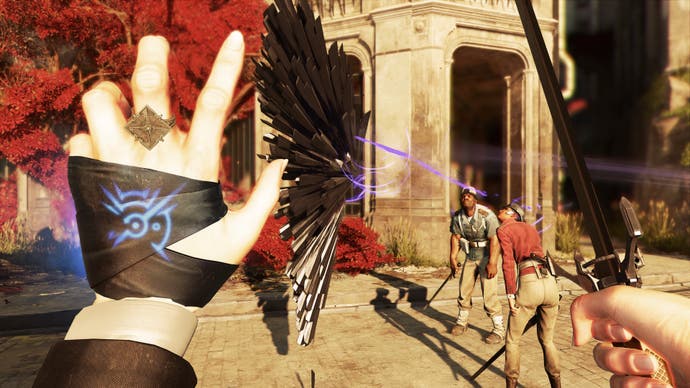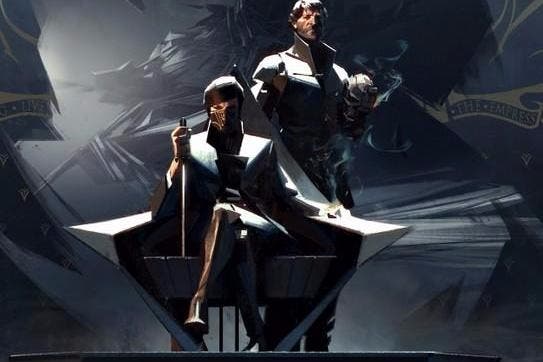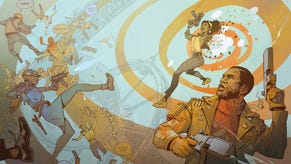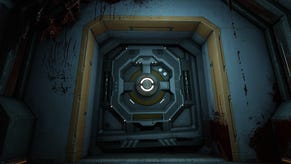Three hours in and Dishonored 2 remains a gleeful laboratory of vindictiveness
For the Kaldwin.
Editor's note: Dishonored 2 is out shortly, and we've just got our hands on final code. We'll be bringing you our full review early next week, but before then here are impressions culled from the game's opening hours.
Dishonored was all about seeking to reclaim the city of Dunwall. Dishonored 2 starts with you trying to escape it. Playing as Empress Emily Kaldwin - or her father Corvo - you're dropped into the shoes of the ruling family fifteen years after the events of the first game, and just as a coup erupts. A mysterious murderer known as the Crown Killer is stalking the streets, offing Emily's foes and simultaneously fitting her up for the crimes, while a foreign dignitary and his clockwork soldiers has just swung by to reveal that Emily's aunt is still alive - and she's also completely evil and fancies the throne for herself. Pretty soon, whichever character you choose to play as, you're under arrest and locked away in a private chamber to await your awful fate.
Hear that? You're left alone inside a locked room. How do you want to play this?
First, of course, there's plenty of poking around to be done. Dishonored 2 retains the first game's emphasis on the singular pleasures of rifling through drawers and bureaus. There are letters and documents to read, but there's also a strangely insectoid typewriter to tap away at, globes to spin, a bizarre clock to set chiming. I did all of this, and spent longer doing it than I would like to admit. Then I peered through the keyhole at the guards grumbling outside on the freshly bloodstained carpet and wondered when my old magic powers would be returned to me. Not right now, by the looks of it. For Dishonored 2's first mission, the designers are playing things thrillingly straight: no teleportation or seeing through walls. Getting out of that locked room requires a much more traditional bit of Tintining - an open window, a ledge, a leap into the parlour next door. And then? Creaking footsteps in the hallway. The game's afoot.
As openings go, it's a reminder of what a powerful stealth experience Dishonored is, even without the magical stuff. Stealth here is a simple affair and all the better for it. Crouch and you're harder to spot and will move more silently. Guards are lumbering piles of gristle for the most part, and will linger for a while, often usefully, at the ends of their patrol routes. When they meet up, they tend to announce what they're about to do next very loudly. On lower difficulties they can be pickpocketed from halfway across the room and will frequently miss a grown woman skulking around the other side of the desk they're sat at. None of these things are criticisms: Dishonored's stealth has simple rules that it abides by, and this means that you can insert yourself right into the game's clockwork and toy with things until they start to break.
As ever, direct violence feels like failure. Your options during the first mission - before you become a magical wraith once more - involve deciding whether to choke guards out or finish them off completely - or leave them patrolling, for added thrills and added satisfaction. There are moments where this freeform approach breaks down ever so slightly, of course - within Dishonored 2's first few minutes you're tasked with tracking a turncoat who simply must be dispatched or at least subdued - but the first mission remains a brilliant reminder of the splinter of free will that lurks at the heart of this enterprise. Dishonored 2 is a game that has you reloading not because you died, but because you survived in a way that you had not planned, and were not pleased with.
Escape from Dunwall itself is by elbowy ironclad steamship, which turns out to be this game's hub, since the Hound Pits Pub has been relegated to the status of an oil painting in that room you were first locked in. This ship is how you get to Karnaca, the sun-faded southern city where the meat of the adventure awaits, and it's also the place you'll explore between missions, and the place where you first get your magical powers back.
Powers first. Choosing to play as Corvo or Emily is ultimately a choice of how you want to handle things. Corvo comes, I gather, with fairly familiar skills. Emily, however, has some interesting tweaks chucked in. Blink has become Far Reach, a far more muscular arcing form of teleportation, while her other powers now have what amount to miniature skill trees attached, opened up by spending the runes you find with that weird clockwork heart that people in Dishonored don't seem to mind carrying around in their pockets.
These powers are beautifully designed, and so a choice whether to spend runes on Domino or Doppelganger, say, gave me genuine pause. Doppelganger allows you to summon a decoy, which, over time, can be powered up to actually kill enemies if left undetected. Domino allows you to entangle the fates of various enemies, so what happens to one of them happens simultaneously to two of them - or three, or four, depending on your rune spend. Here, and in the combination of the powers, you get a sense of Dishonored 2's potential as a laboratory of vindictiveness. Then again - and after the first mission this was rather appealing - you could choose to avoid powers altogether and play the game entirely straight. This option by itself is surely a real sign of Arkane's confidence in the systems it has created.
Karnaca is equally enticing with either approach, thankfully. Honey-coloured and rotting, this is almost a Venetian fantasy, with all the beauty and pestilence that suggests. Its avenues are narrow and it has the same pleasing verticality of Dunwall: every Wall of Light you encounter has numerous options for depowering it, going around it, or going over. Arrival here sees the streets flowing with the blood of gutted fish, while the interior suggests a city struggling against a repressive force. Once again your own actions will ultimately decide the fate of this place, its character changing with each enemy you spare or despatch.

If Karnaca proves that Arkane's art designers have found a way to infuse the balmy med with its own kind of misery, my first mission in this strange space became wonderfully Gothic. Emily (or Corvo) is in Karnaca to learn more about that Crown Killer, and my first foray led me into town to a train station - although it was hardly a station, and hardly a train - and then out across the water to a kind of Alcatraz of infection: a sanitorium and research institute of sorts for victims of plagues.
It's a perfect Dishonored space, roomy and complex, yet with fewer obvious places to hide than you might initially expect. Explore, and you'll find that hallways and byways have a habit of funnelling you back to the central atrium, overrun with enemies, while travelling up or down in the elevator that provides a sort of spine to the building, offers a moment of respite while also building up the sense of claustrophobia: I'm deep into this now, but how am I going to get back out again?
Luckily, by the time I got here, even a person as clumsy as I am at stealth was starting to get my bearings and settle into that old Dishonored feeling. It's a feeling of exploring a space that's filled with potential and distractions, but which still manages to provide a clear sense of forward momentum, a hand gently at your back. Meanwhile, your powers work together with the basic stealth and combat set-up to provide a game that offers not just choice but adaptability and dynamism. Dishonored's often seen as a game that offers a wide range of ways to approach things, but it's also a game that gives you plenty of options on the fly when you've got things wrong.
New hub, new city, new characters and new powers - and yet my first few hours with Dishonored 2 suggested a game that, in all the right ways, is offering many of the pleasures of the last outing. More of the same? Not quite: instead this feels like a deeper rumination on the ideas that first came together back in Dunwall. It's progress, but it's so player-centric that it allows you to explore new elements at your own pace - if you want to at all. The gentle hand remains at your back, but there's still plenty for you to think about.










